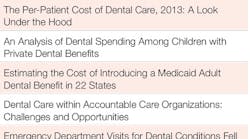Promising ADA reports: Physicians desire a greater role; dental patients do place value on expenses
By Christine Nathe, RDH, MS
The American Dental Association (ADA) Health Policy Institute recently published numerous articles regarding current dental care delivery in the United States. These reports provide an excellent snapshot of what's happening in dental care delivery. These publications include information that can help dental hygienists when addressing state and local issues and developing solutions to dental care issues.
The reports detailed the physician-dentist referral process, dental care spending and costs, Medicaid adult benefits, accountable care organizations, and emergency dental visits (see Table 1). Physicians reported dissatisfaction with the current system for referring to dentists, dental care coverage for their patients, and their ability to distinguish a worrisome oral lesion from a variant of normal. The further integration of dental hygienists within health systems seems like a promising solution to these issues. Dental hygienists could act as case managers while providing education to patients and physicians, much like Fones originally envisioned. Further collaboration of dental care into health systems is discussed in the report on Accountable Care Organizations (ACO), which suggests that ACOs would be interested in the integration of dental health into health information technologies.
Although studies report dental costs to be a significant barrier to treatment, Table 2 provides telling information about this barrier. Interestingly, out-of-pocket payment for dental costs was significantly higher than other health services, which may indicate a value issue as well.
In the report about children it was noted that more than one in four children ages 1 to 18 with private dental benefits do not have a single dental claim within the year, which indicates that those with insurance are still not visiting their dental providers regularly. This is another compelling value issue.
The adult report revealed that 22 states do not provide any dental benefits to adults in their Medicaid programs beyond emergency procedures. Good news is that the number of emergency department visits for dental conditions in the United States fell from 2012 to 2013, the first decline since the early 2000s. These reports are excellent resources for dental hygienists who are working on access and utilization issues within their states. RDH
CHRISTINE NATHE, RDH, MS, is director at the University of New Mexico, Division of Dental Hygiene, in Albuquerque, N.M. She is also the author of "Dental Public Health Research" (www.pearsonhighered.com/educator), which is in its third edition with Pearson. She can be reached at [email protected] or (505) 272-8147.








